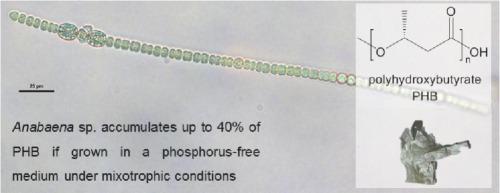International Journal of Biological Macromolecules ( IF 7.7 ) Pub Date : 2021-09-15 , DOI: 10.1016/j.ijbiomac.2021.09.054 Mara Simonazzi 1 , Laura Pezzolesi 2 , Paola Galletti 3 , Chiara Gualandi 4 , Rossella Pistocchi 2 , Nicole De Marco 1 , Zoe Paganelli 1 , Chiara Samorì 3

|
Polyhydroxybutyrate (PHB) production by the cyanobacterium cf. Anabaena sp. was here studied by varying the medium composition and the carbon source used to induce mixotrophic growth conditions. The highest PHB productivity (0.06 gPHB gbiomass−1 d−1) was observed when cultivating cf. Anabaena sp. in phosphorus-free medium and in the presence of sodium acetate (5.0 g L−1 concentration), after an incubation period of 7 days. A content of 40% of PHB on biomass, a dry weight of 0.1 g L−1, and a photosynthetic efficiency equal to the control were obtained. The cyanobacterium was then grown on a larger scale (10 L) to evaluate the characteristics of the produced PHB in relation to the main composition of the biomass (the content of proteins, polysaccharides, and lipids): after an incubation period of 7 days, a content of 6% of lipids (52% of which as unsaturated fatty acids with 18 carbon atoms), 12% of polysaccharides, 28% of proteins, and 46% of PHB was reached. The extracted PHB had a molecular weight of 3 MDa and a PDI of 1.7. These promising results demonstrated that cf. Anabaena sp. can be included among the Cyanobacteria species able to produce polyhydroxyalkanoates (PHAs) either in photoautotrophic or mixotrophic conditions, especially when it is grown under phosphorus-free conditions.
中文翻译:

由蓝藻生产聚羟基丁酸酯,参见。鱼腥藻
蓝藻产生的聚羟基丁酸 (PHB),参见图 1。鱼腥藻 在这里通过改变培养基组成和用于诱导混合营养生长条件的碳源进行研究。当培养比照时观察到最高的 PHB 生产力(0.06 g PHB g生物量-1 d -1)。鱼腥藻 在无磷培养基和醋酸钠(5.0 g L -1浓度)存在下,经过 7 天的培养期。生物质中PHB含量为40%,干重0.1 g L -1,并获得与对照相同的光合效率。然后蓝藻在更大规模(10 L)上生长,以评估与生物质的主要成分(蛋白质、多糖和脂质的含量)相关的产生的 PHB 的特征:经过 7 天的潜伏期,脂质含量达到6%(其中52%为碳原子数为18的不饱和脂肪酸)、12%的多糖、28%的蛋白质和46%的PHB。提取的 PHB 的分子量为 3 MDa,PDI 为 1.7。这些有希望的结果表明,cf。鱼腥藻 可以包括在能够在光自养或混合营养条件下产生聚羟基链烷酸酯 (PHA) 的蓝藻菌种中,特别是当它在无磷条件下生长时。









































 京公网安备 11010802027423号
京公网安备 11010802027423号